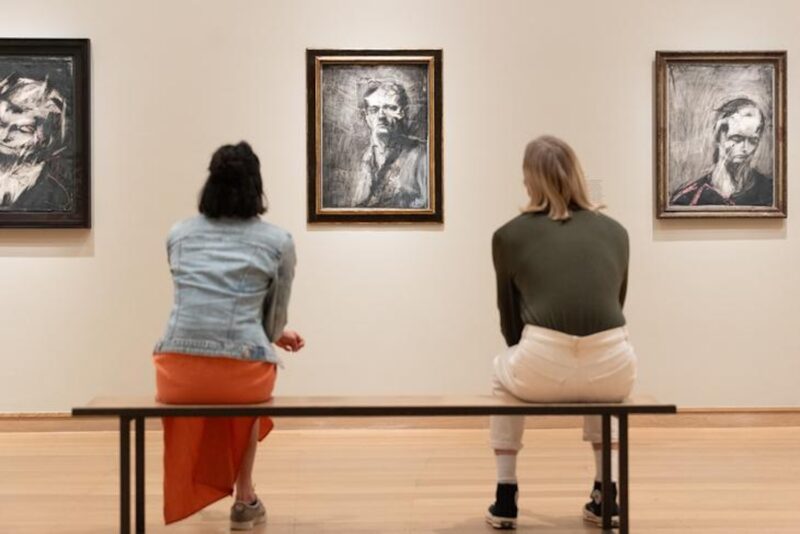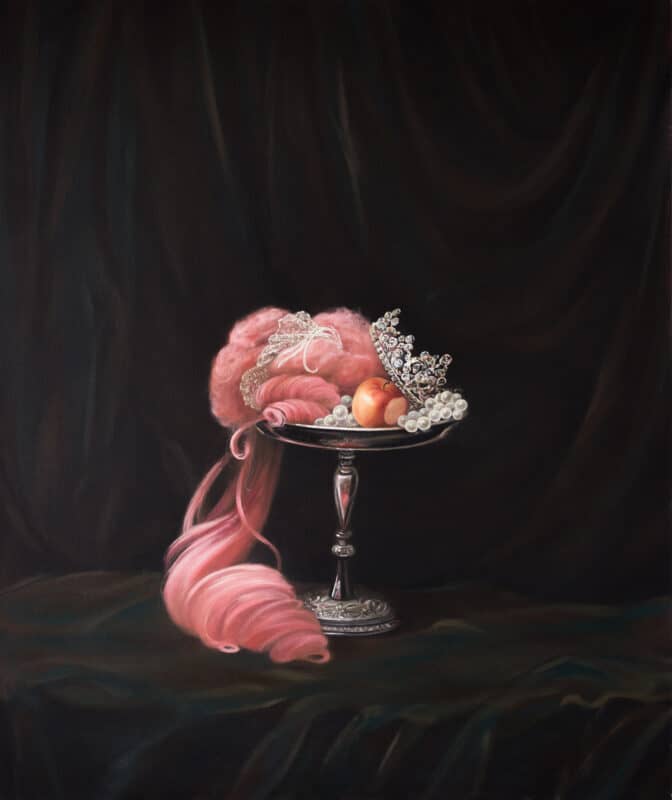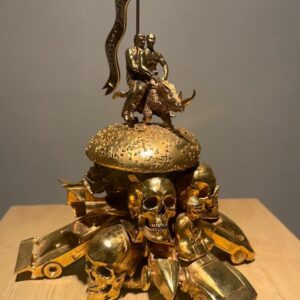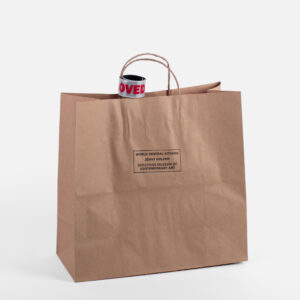
STUDIO WEST presents The Blush Upon Her Cheek, a multidisciplinary exhibition of works by Leo Costelloe, Florence Reekie and Ki Yoong. Drawing from Restoration Court painter Sir Peter Lely’s Windsor Beauties (1660s), a set of eleven portraits depicting ladies of the court of King Charles II, the exhibition sees a trio of contemporary artists examine the problematics entrenched in the cultivation and appreciation of beauty.
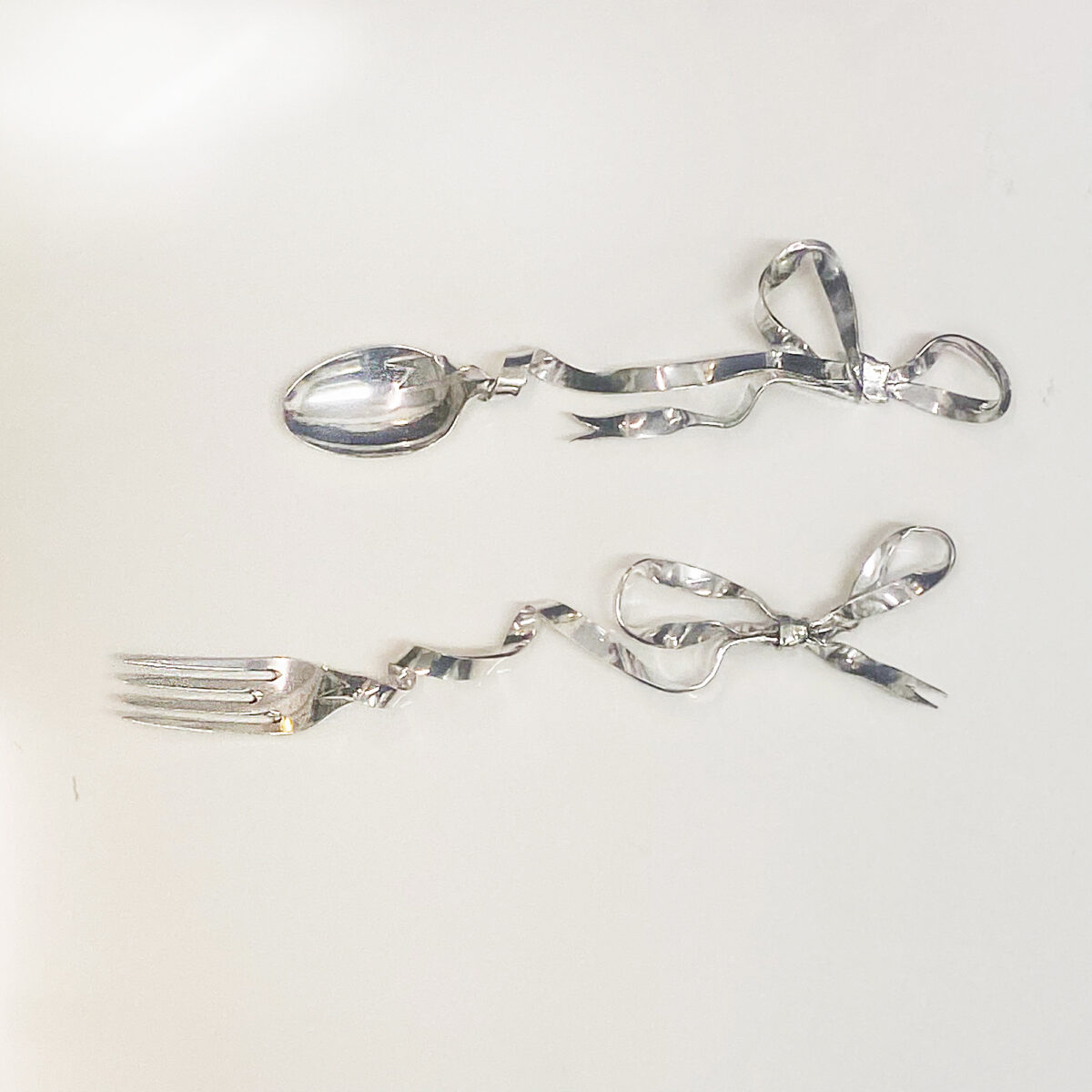
Mirroring the Restoration Court’s penchant for the decadent, Leo Costelloe’s sumptuous and subtle sculptural pieces speak to the relationship between gender and adornment. By recasting women’s beautification tools – ribbons, bows, combs and necklaces – in incongruously hard materials such as glass and silver, the artist disrupts these items’ presupposed gender affiliations. When a ribbon is transmuted from silk to silver, its recognisable fluidity and smoothness give way to an almost threatening sharpness. What remains is an uncanny object that, through its material dissonance, rejects functionality while breaking free from its feminine associations. By isolating these intimate items on plinths and offering no suggestion as to whom they may belong, the artist further dissolves the assumption that they are intended for women: when standing alone, a necklace is both for everyone and no one. This act of separation also imbues Costelloe’s pieces with a unique self-determination – the inanimate become beautiful in their own right. The viewer comes to understand the powerful contribution of objects used for adornment to the construction of beauty, and the trappings of self-fashioning are revealed.
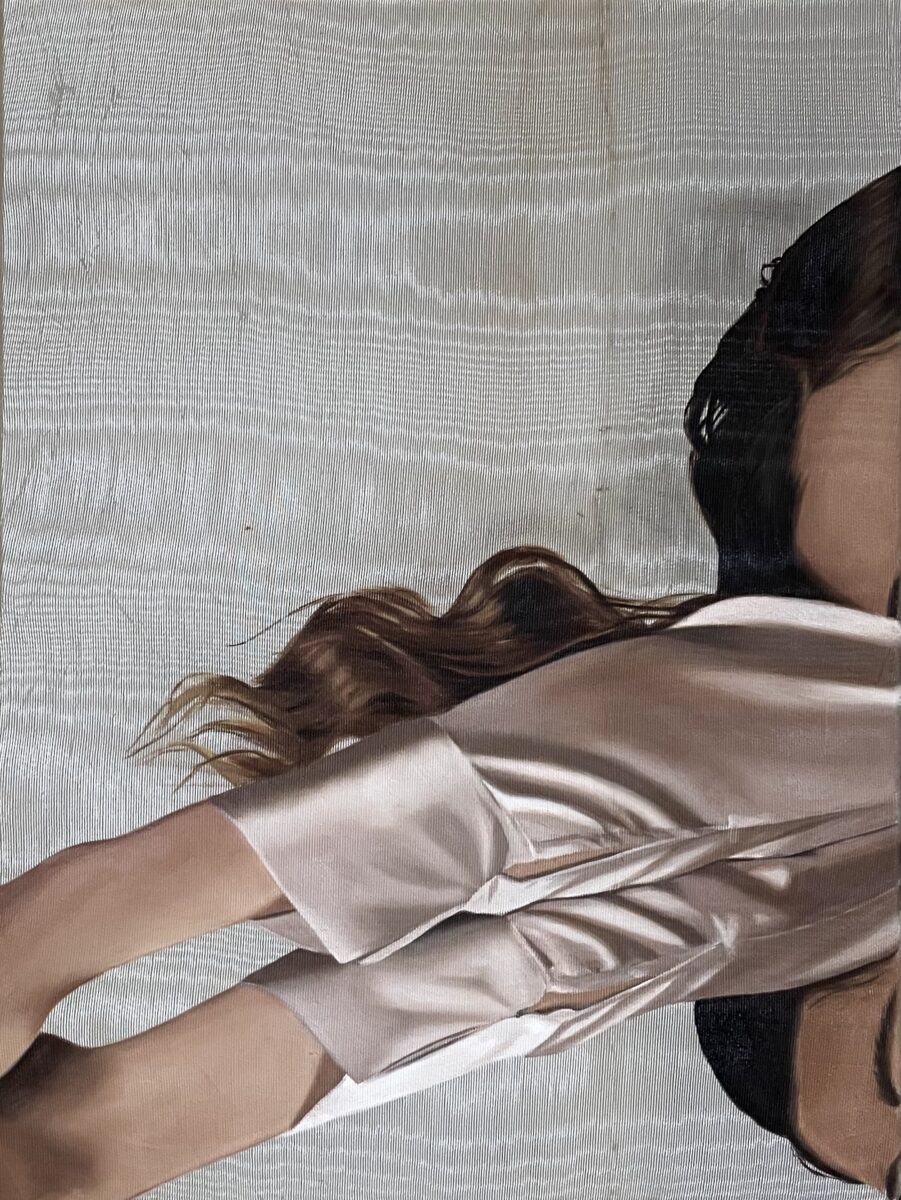
Like Costelloe, Florence Reekie is similarly interested in the art of beautification. The artist liberates drapery from its classical role as mere staging in painting – exemplified by Lely’s Windsor Beauties – and instead deploys it as a tool to examine an individual’s self-presentation. Positioned as the primary subject of each piece, items of clothing take on deeper meaning in Reekie’s work; a single silk glove, for example, stands in for the figure who wears it. Disguised in elegantly flowing swathes of fabric, her sitter’s fashion becomes the conduit or concealer of their identity. The luxurious and perfectly rendered fabrics that ripple across her canvases become synonymous with the implied beauty of her hidden subjects. The artist also positions her pieces in dialogue with the contemporary beauty-industrial-complex, with titles inspired by the promises of cosmetic products, such as Even Toned and Flawless. Toying with the idea of ‘beauty secrets’, she underlines the false assurances at play in the enhancement tools most commonly marketed to women in search of perfection, while illuminating the inherent unattainability of culturally enforced beauty standards. This is further reinforced by her deliberate use of recycled fabrics as canvases. In leaving traces of the fabric’s past life visible in the final piece, she plays with the dichotomy between decadence and frugality, alluding to the central theme of her work – the space between real and heavily cultivated appearances.
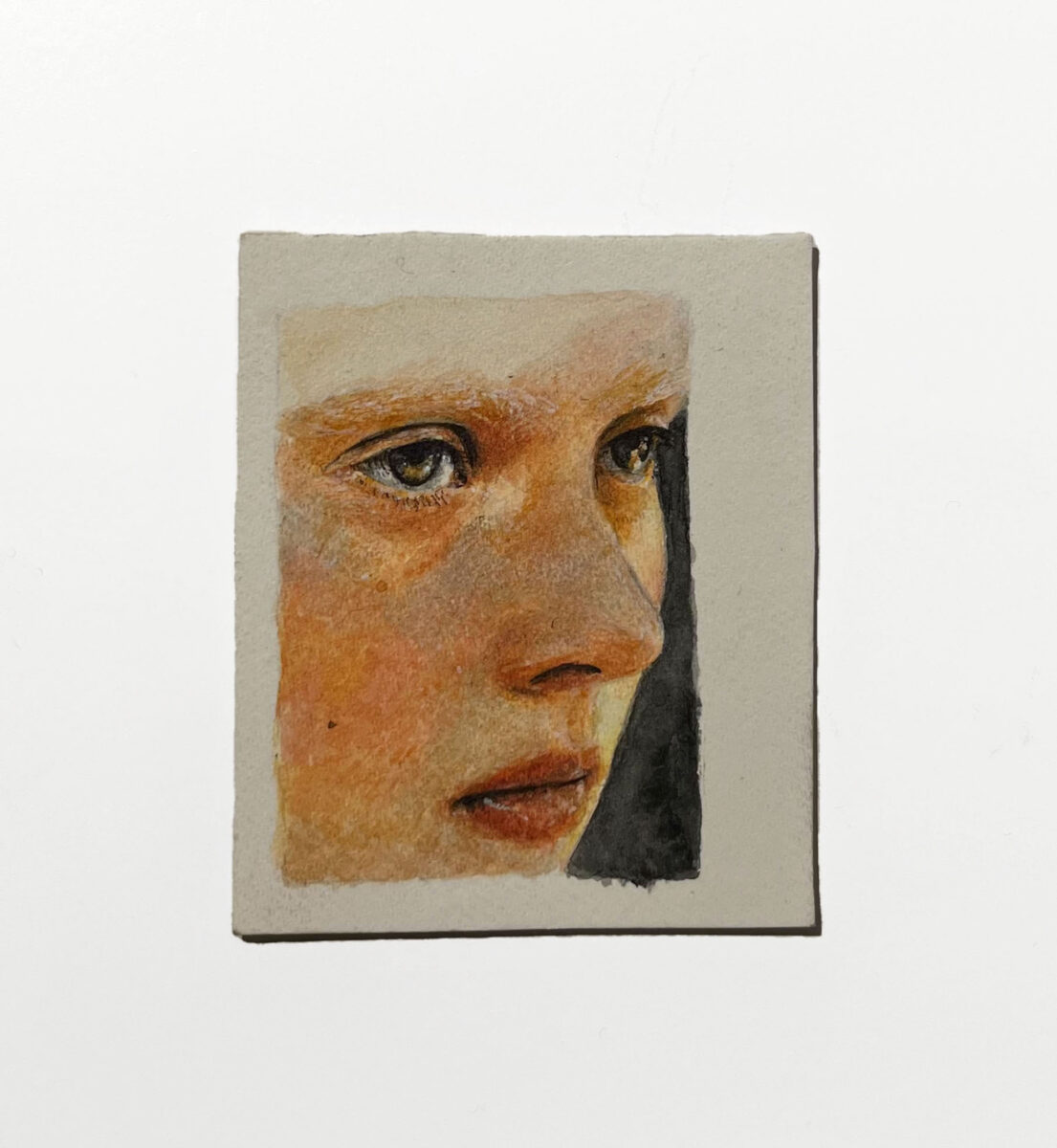
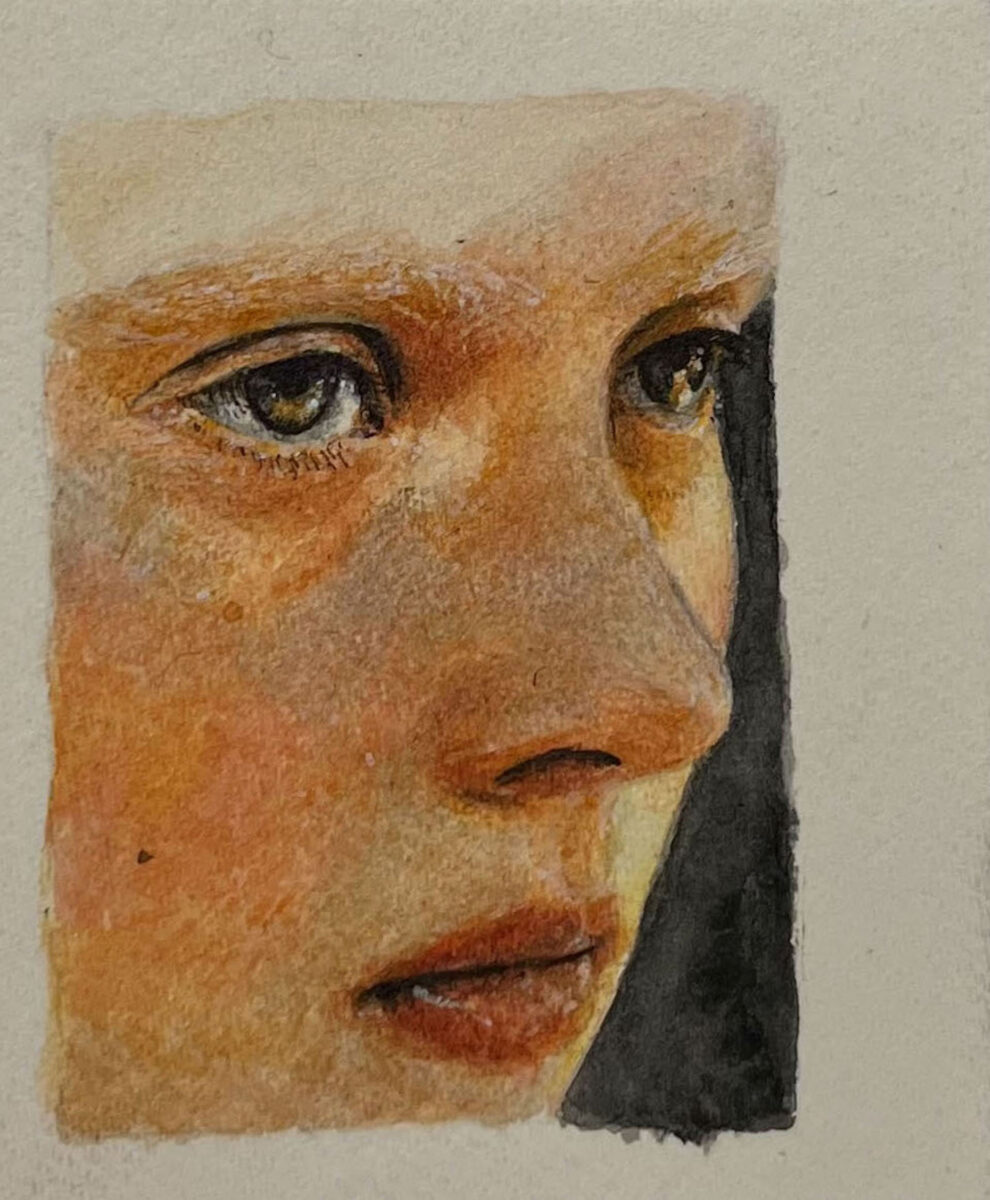
Drawing direct inspiration from the Windsor Beauties, Ki Yoong’s eleven tender portraits exist almost as a revision of Lely’s original set, further expanding the definition of beauty while engaging with the seventeenth-century proposition that outer beauty is mirrored internally. Featuring a spectrum of individuals, Yoong’s presentation of each of his sitters is true to life. Unlike Lely’s idealised Beauties, Yoong illuminates what makes each person uniquely alluring. Owing to his fastidious attention to detail, made manifest by his intricate brushwork and bespoke framing, every piece feels precious and demands to be cherished. This in turn, implies that all those pictured, despite their differences, harbour a distinct charm worthy of the artist’s immense affection: their open, welcoming faces inviting the viewer to discover their latent beauty. Yoong’s use of light further accentuates the attractiveness of each sitter: every one is framed by an amber-hued glow that seems to emanate from within. In foregoing background detail in place of an intense and closely cropped focus on the face, meanwhile, Yoong deliberately leaves much of the sitter’s story to the imagination. By merely regarding the tranquil visage before them, the viewer must infer the emotions and identity of the individual pictured. Their peaceful expressions and harmoniously balanced features, coupled with the artist’s aforementioned use of a gentle, enticing light, draws the viewer to only one conclusion – that the sitter’s outer beauty is reflected within.
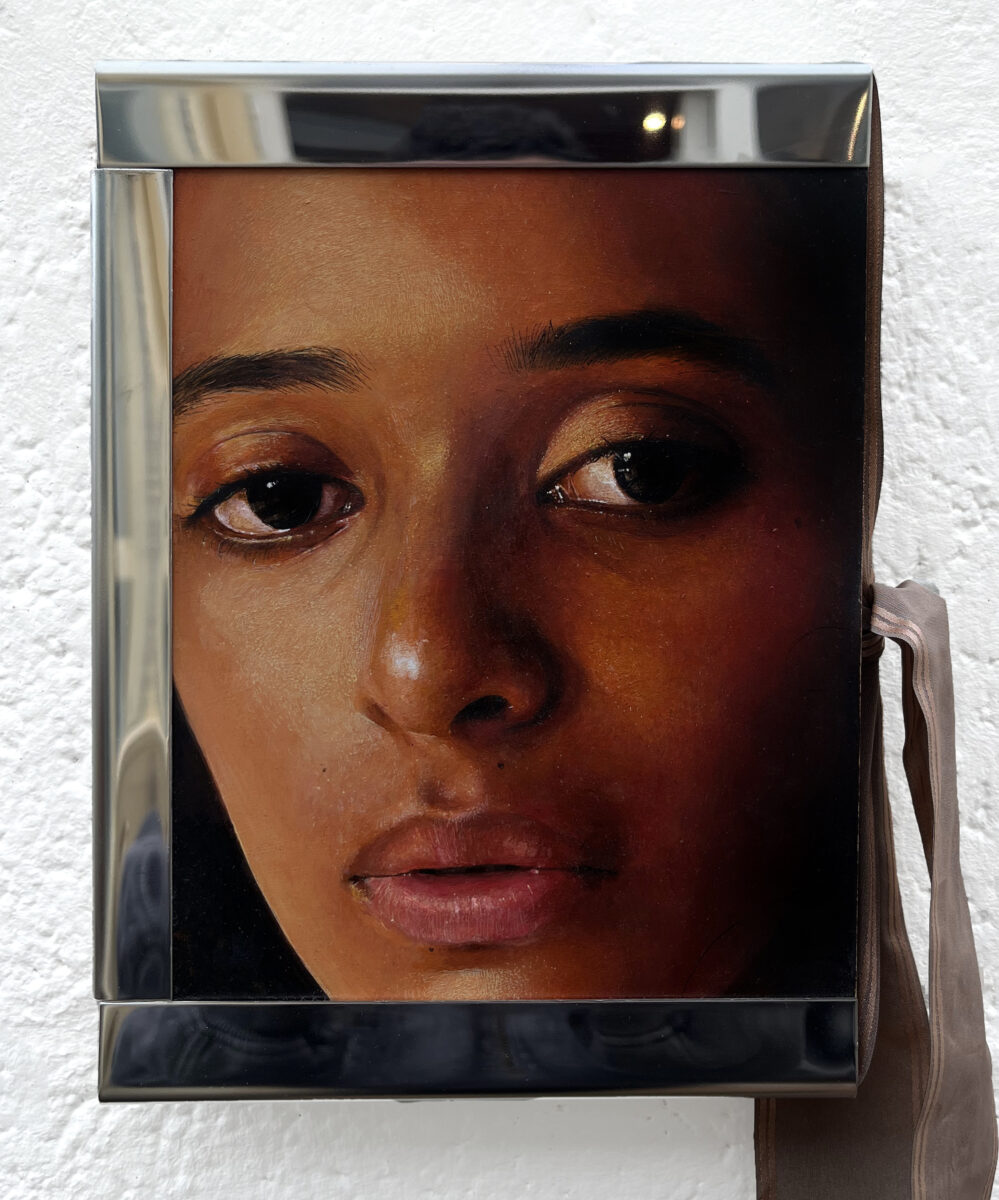
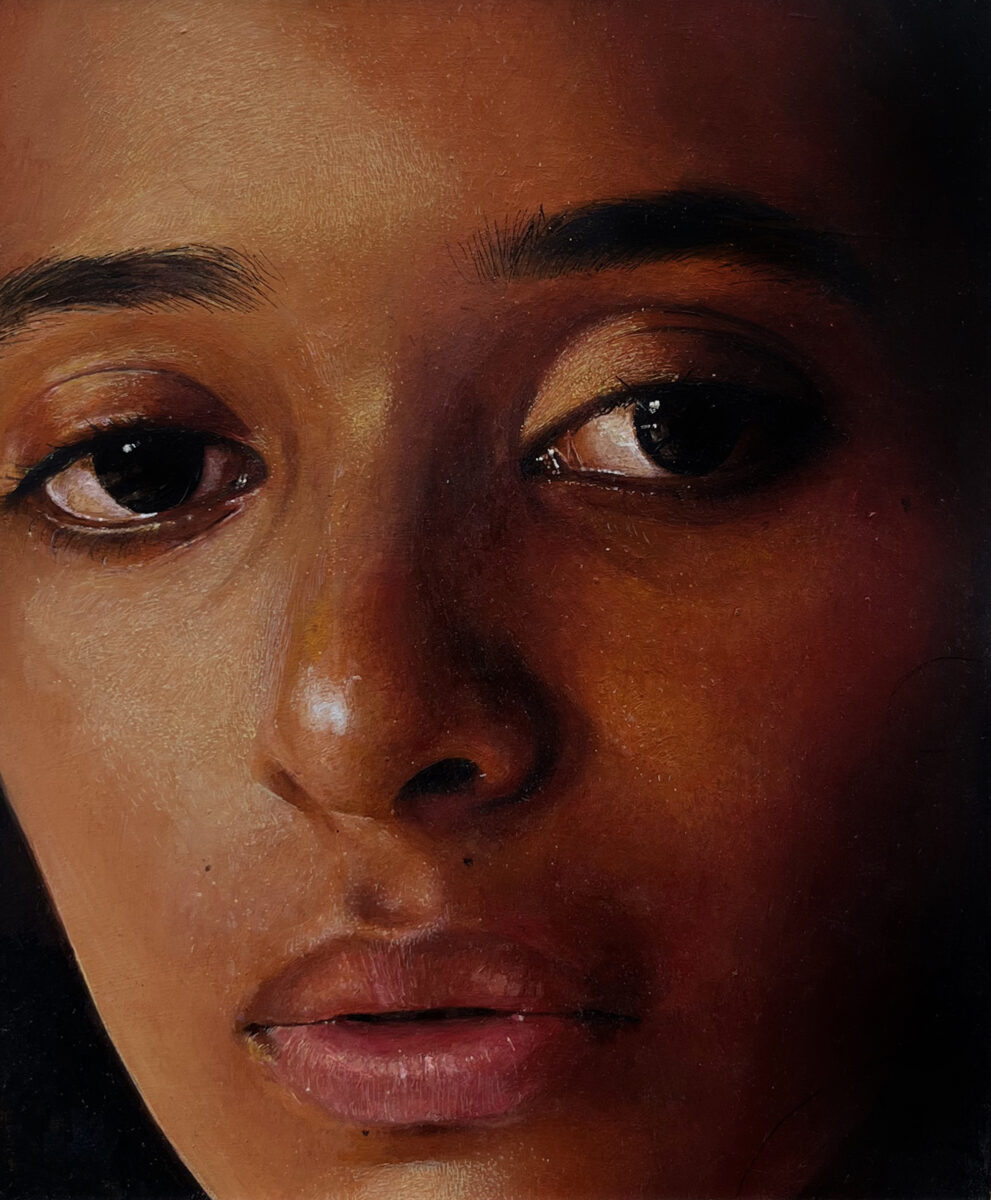
Peter Lely’s Windsor Beauties are emblematic of the timeless struggle to attain inherently inaccessible societal beauty standards, most commonly associated with women. By examining Lely’s portraits through a contemporary lens, artists Leo Costelloe, Florence Reekie and Ki Yoong create new works that unpick age-old ideas of beauty, ultimately leaving the viewer to question the extent to which modern society has surpassed the Restoration Court’s obsession with aesthetic perfection.
The Blush Upon Her Cheek, 25th January – 22nd February 2024, STUDIO WEST
About the artists
Leo Costelloe (they/them) explores the transient and sentimental nature of objects through their work in glass, metal and silver. In Costelloe’s practice, otherwise banal items are imbued with complex emotional and symbolic resonances informed by the artist’s tenuous rural childhood and grinding coming-of-age in the East London queer scene. A familiar object, such as a simple bow, takes on new meaning when rendered in glass and displayed on a gallery wall; it becomes a somewhat haunting, ghostly apparition or perhaps the manifestation of a long-forgotten childhood memory.
Costelloe’s practice borrows from the zeitgeist of digital femininity, with leitmotifs including dolls, flowers, stars and aforementioned bows reappearing across their oeuvre. Yet, the artist’s identification with the girlish is inherently subversive; by literally recasting historically feminine signifiers in unexpected materials, Costelloe disrupts gendered assumptions. Reproducing the folds of a silk ribbon in metal, the artist harnesses material dissonance as a tool to reframe an object’s presupposed affiliations. Costelloe’s engagement with the decorative and their immense attention to detail lend the artist’s work a uniquely precious quality: each piece gently demands that it be cherished. When taken together, Costelloe’s entrancing works assume an almost mythic quality, acting as an invitation to embrace the artist’s delicately constructed fantasy.
Leo Costelloe (b.1993) is an Irish-Australian artist who lives and works in London. They completed a BA in Jewellery Design at Central Saint Martins (2021). They have presented two previous solo exhibitions at Ridley Road Project Space, London (2022) and Kupfer Gallery, London (2023) and a duo show at Guts Gallery, London (2023) curated by Helen Neven. They were awarded the Swarovski Scholar Award (2020) after having been a finalist for the same in 2019.
Their work has been featured in group exhibitions by galleries including: Kupfer Gallery, London (2023); Indigo + Madder, London (2023); Photobook Gallery, London (2023) and Ridley Road Project Space, London (2022) curated by George Henry Longly. They have worked with a variety of brands and institutions including: Show Studio, The British Fashion Council and Dover Street Market, New York. In September 2020, they undertook a residency in glass with Artist Andrea Spencer in Northern Ireland.
Informed by her passionate interest in the materiality and luminosity of oil paint, Florence Reekie’s highly-detailed and delicately rendered works reimagine the role of drapery in painting, often featuring glimmering swathes of fabric, hands elegantly encased in silk gloves or flowing ribbons that have been mysteriously discarded. Rather than positioning drapery as mere staging for the figure, Reekie deploys it as the body’s veil or armour in dialogue with contemporary fashion and a complex understanding of identity and self presentation. By drawing attention to drapery, a long-standing yet often overlooked element of classical painting, Reekie’s work ignites discussion around identity, vanity and perception. She is interested in the way in which an individual’s aesthetic presentation is socially coded, investigating the lacuna between authenticity and assimilation. In particular, she toys with the idea of ‘beauty secrets’ – hidden gestures typically associated with women’s attempts to align themselves with a certain cultural notion of beauty.
Often utilising recycled fabrics, in particular Moire Silk, as canvas, the artist paints upon the very material she depicts thereby underlining the primacy of surface and texture within her work. By leaving traces of the fabric’s past life – seams, marks and mild stains – visible in the final piece, meanwhile, she plays with the dichotomy between decadence and frugality alluding to the central theme of her work – the space between heavily cultivated appearances and unseen realities.
Florence Reekie (b.1991) lives and works in Edinburgh, Scotland. She completed the Turps Correspondence Course (2021-2022). In 2023, she presented her debut solo exhibition with MAMA Gallery, London and was shortlisted for the John Moores Painting Prize. In 2021, she was awarded the Art Fund ‘Museum of the Year’ Aberdeen Art Gallery Micro Commission. Her work has been featured in group exhibitions by galleries and curatorial projects including: York Street Gallery, London (2023); STUDIO WEST, London (2023); Artistellar Gallery, London (2023); Art on a Postcard’s War Child Auction at Soho Revue, London (2023) and MAMA Gallery, London (2023) among others.
Ki Yoong’s highly-detailed, delicately rendered and undeniably beautiful portraits celebrate the uniqueness of every face, focussing on it as the primary conduit of emotion and identity, while seeking to challenge the assumed relationship between the observer and the observed. The tenderness and care Yoong brings to his work, exemplified by his thoughtful compositions, intricate brushwork and bespoke framing, invites a sense of intimacy between the subject and the viewer; on observing his work, one feels they are in the presence of a cherished object that has been painstakingly and lovingly created. His deliberate foregoing of background detail in place of an intense and closely-cropped focus on the face, meanwhile, leaves much of the sitter’s story to the imagination. Confronted with the stillness of a face hanging elegantly in a room, one immediately wonders: Who are they?
In this way, Ki carefully controls the viewer’s relationship with the subject. In the absence of context, the individual pictured exists almost like a mirror to the viewer – they automatically project their own assumptions, biases and experiences onto the face that stares back at them. The gap between what is seen and what is understood is thus filled by the complex tapestry of the viewer’s own life, history, desires and aspirations. In place of gaining insight into the subject as they observe, the viewer is therefore invited to learn more about themselves.
Ki Yoong (b.1988) lives and works in London. He completed a BA in Fine Art at The University of Leeds, and an MFA in Fine Art at Central Saint Martins. In 2023, he presented his debut solo exhibition with Slugtown, Norwich. His work has been featured in group exhibitions by galleries including: Marlborough Gallery, London (2023); STUDIO WEST, London (2023) and Brooke Benington, London (2023) among others. He has collaborated with a variety of brands and institutions including Vogue, Alex Eagle, Paul Smith and The House of St Barnabas. He also works with schools and third-sector organisations across London teaching art.
